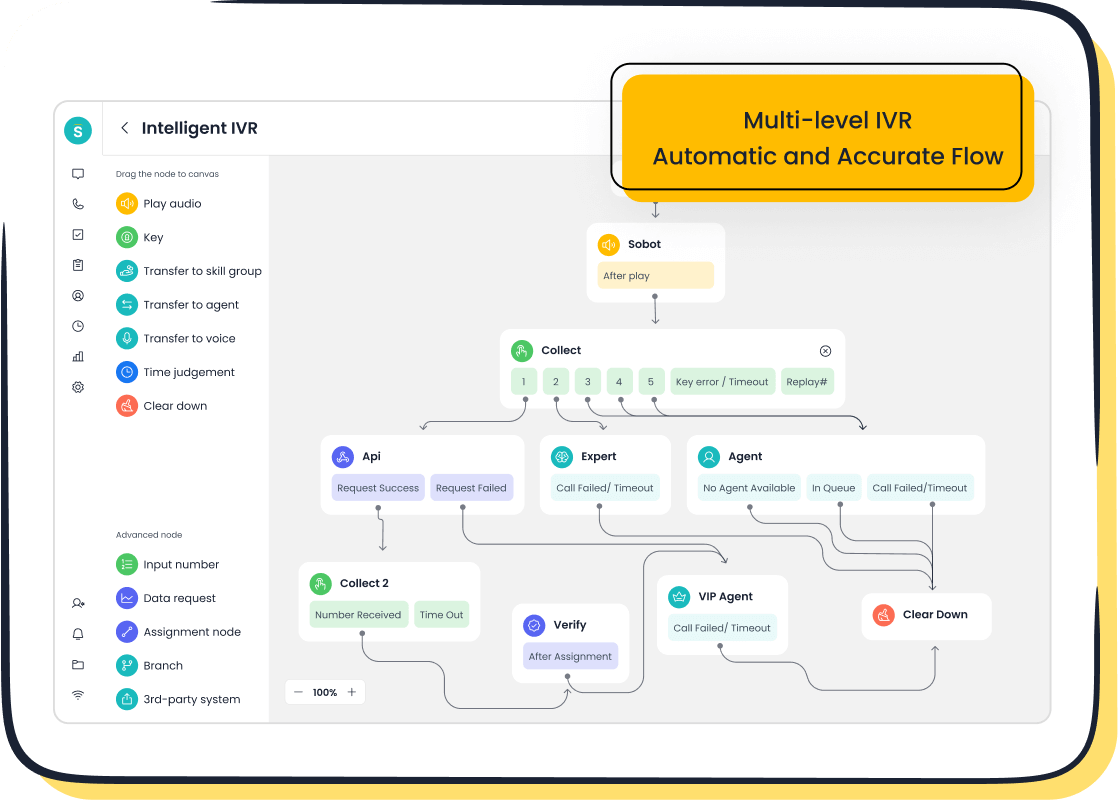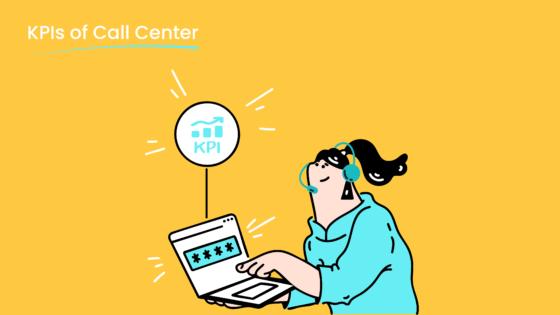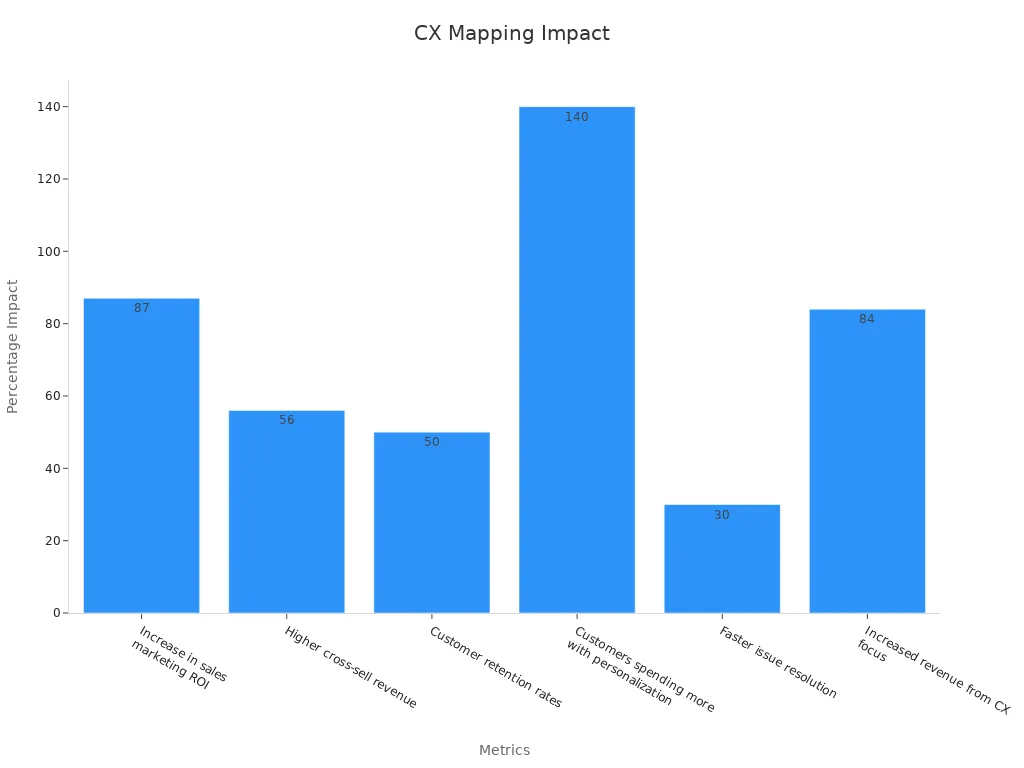Contact Center Customer Journey Mapping for Better Service

Understanding the contact center customer journey shapes every interaction and drives better service. Companies now use analytics to spot hesitation points, like a makeup brand that added a virtual try-on and saw higher satisfaction. Customer journey mapping uncovers pain points, builds trust, and boosts experience across every channel. Personalization and a seamless omnichannel journey increase loyalty and customer satisfaction. Sobot AI helps businesses unify data and monitor feedback, creating a 360-degree customer view that improves experience, reduces churn, and strengthens the journey at every touchpoint.
Customer Journey Mapping Benefits

Improving Customer Experience
Customer journey mapping gives organizations a clear view of every step a customer takes. By understanding each journey stage, companies can personalize interactions and address pain points before they grow. Sobot’s omnichannel solution helps unify customer data, making it easier to deliver consistent service across all channels. This approach leads to higher customer satisfaction and loyalty.
Companies track customer satisfaction using surveys like CSAT, NPS, and CES. These tools provide real numbers on how customers feel about their experience. Businesses also monitor complaint resolution times and first-contact resolution rates. When teams act on feedback—by personalizing service, improving product quality, and training staff—customer satisfaction scores rise. For example, Sobot’s AI-powered analytics help companies spot recurring issues and measure the impact of new customer experience initiatives.
Note: Regularly collecting and analyzing feedback at each journey touchpoint allows businesses to react quickly and improve the overall customer experience.
Customer journey mapping also helps companies compare their scores with industry benchmarks. This process supports continuous improvement and keeps the customer at the center of every decision.
Boosting Operational Efficiency
Mapping the contact center customer journey streamlines operations and boosts efficiency. By visualizing the journey, managers can allocate resources where they matter most. Sobot’s unified workspace and AI-driven tools help agents access customer information quickly, reducing average handle time and improving first-contact resolution.
Companies use metrics like Customer Effort Score (CES), CSAT, and NPS to measure operational success. These numbers show how easy it is for customers to complete actions and how well the team resolves issues. Journey mapping highlights bottlenecks and inefficiencies, allowing teams to make data-driven decisions that cut response times and remove redundant steps.
- Customer journey mapping supports:
- Smarter resource allocation
- Better employee training
- Proactive issue resolution
- Continuous process improvement
When agents participate in mapping their own journey, they help identify pain points and suggest improvements. This collaboration increases job satisfaction and reduces turnover, which further enhances operational performance.
Contact Center Customer Journey Map Types
Current-State Maps
A current-state customer journey map shows the real experience customers have with a contact center. Teams use this map to find pain points and see where customers struggle. For example, a current-state map might reveal that customers wait too long for support or get confused by automated menus. These maps help teams align around the real customer journey and understand emotions and behaviors at each step. Companies like USA.gov have used current-state maps to spot where products do not meet customer needs and to guide improvements. Teams often use research data and interviews to build these maps, making sure they reflect the true customer journey.
- Teams use current-state maps to:
- Communicate pain points to stakeholders
- Align departments with the customer journey
- Audit existing efforts and challenge old assumptions
Future-State Maps
A future-state customer journey map imagines the ideal journey for customers. This map helps teams plan changes and set goals for better service. By comparing the current and future states, companies can see what needs to change. For example, the GSA created a future-state roadmap to guide contact center improvements, identify gaps, and measure success. Best practices include gathering data, working with stakeholders, and tracking key performance indicators like efficiency and ROI. Future-state maps act as a “North Star,” inspiring teams to prioritize resources and create a better customer journey.
- Identify gaps between current and future journeys
- Develop a plan for transformation
- Measure progress and adjust as needed
Service Blueprint Maps
A service blueprint map adds another layer to the customer journey map by showing what happens behind the scenes. It includes employee actions, technology, and support processes. This map helps teams see how internal steps affect the customer journey. For example, a hotel chain used service blueprints to reduce check-in wait times and improve guest communication. Service blueprints help companies find weak spots, improve cross-team work, and deliver better service.
| Industry | Benefit | Result |
|---|---|---|
| Healthcare | Reduced wait times, better satisfaction | 25% fewer complaints |
| Retail | Improved layouts, better training | 15% higher sales |
| Financial Services | Easier onboarding, more engagement | 30% more customer retention |
Persona-Based Maps
A persona-based customer journey map focuses on different customer groups. Each persona represents a type of customer with unique needs and challenges. By mapping journeys for each persona, teams can personalize service and spot new opportunities. For example, a global software company used persona-based maps to improve engagement and reduce costs. Research shows that using personas leads to 25% lower service costs and 40% higher conversion rates. Teams gain a better understanding of their customers, which leads to more confident and accurate decisions.
Tip: Persona-based maps help teams design targeted solutions for each customer group, making the customer journey more personal and effective.
Comparing Customer Journey Mapping Approaches
Assumption-First vs. Research-Driven
Contact centers often start customer journey mapping with two main approaches: assumption-first and research-driven. The assumption-first method relies on what teams believe about the customer journey. Teams may use their own experience or internal discussions to build a customer journey map. This approach can move quickly, but it often misses real customer needs and behaviors.
Research-driven mapping uses data from real customer interactions. Teams gather feedback, analyze support tickets, and conduct interviews. This method takes more time, but it creates a more accurate customer journey map. For example, the Telus and Bridgeable case study showed that teams assumed customers used only one channel to renew contracts. Research revealed that customers actually used multiple channels. By switching to a research-driven approach, Telus improved customer satisfaction by 20% and increased digital channel use by 25%. Boeing also found that research-driven customer journey maps helped them understand customer experience across roles and channels, leading to better service and transformational change.
Note: Research-driven customer journey mapping uncovers hidden pain points and helps teams design solutions that match real customer behavior.
| Approach | Pros | Cons |
|---|---|---|
| Assumption-First | Fast to create, easy to start | May miss real customer needs, less accurate |
| Research-Driven | Accurate, based on real customer experience | Takes more time, needs more resources |
Data-Driven Mapping
Data-driven mapping uses facts and analytics to build a customer journey map. Teams collect data from every customer touchpoint, such as calls, chats, and emails. This approach helps contact centers see the full customer journey and spot trends. Customer journey analysis tools can show where customers drop off or get frustrated.
Sobot’s omnichannel solution and Voice/Call Center products support data-driven mapping. These tools unify customer data from all channels into one workspace. Agents can see the entire customer journey, from first contact to resolution. Sobot’s analytics highlight pain points and measure the impact of changes. This leads to better customer experience and smarter decisions.
Customer journey mapping with data-driven tools helps teams:
- Track customer satisfaction and experience in real time
- Identify and fix bottlenecks in the journey
- Personalize service based on customer history
Tip: Data-driven customer journey maps give teams the power to act quickly and improve the customer experience at every step.
Journey Orchestration
Journey orchestration takes customer journey mapping to the next level. It uses real-time data and automation to guide each customer through the best path. Contact centers can deliver personalized experiences across channels, such as voice, chat, SMS, and WhatsApp.
A financial services firm used AI-driven journey orchestration to send the right message at the right time. They used real-time segmentation and omnichannel messaging, which led to a 25% increase in customer retention and a 30% rise in cross-sell opportunities. Experts agree that journey orchestration uses integrated data to predict customer needs and trigger actions that improve the customer experience.
Sobot’s omnichannel and Voice/Call Center solutions enable journey orchestration by:
- Integrating customer data from all channels
- Using AI to automate responses and route inquiries
- Providing a unified workspace for agents to manage the customer journey
| Industry Sector | Use Case Description | Outcomes Achieved |
|---|---|---|
| Retail | Personalized interactions and increased engagement | Higher customer engagement and sales growth |
| Financial Services | Streamlined support and personalized services | Improved customer satisfaction and retention rates |
| Healthcare | Optimized multi-channel communication and patient engagement | Enhanced patient experience and care continuity |
Journey orchestration ensures every customer receives a seamless, personalized experience, no matter which channel they use.
Customer journey mapping, data-driven mapping, and journey orchestration all help contact centers improve the customer journey. Sobot’s solutions make it easy to unify data, automate tasks, and deliver outstanding customer experience at every stage.
Steps to Map the Contact Center Customer Journey

Research and Data Collection
The first step in the customer journey mapping process involves gathering both qualitative and quantitative data. Teams collect information from customer support logs, analytics, and satisfaction scores. They also conduct interviews and surveys to understand customer emotions and motivations. Combining these methods gives a complete view of the customer journey. Sobot’s unified workspace helps teams access real-time and historical data from every channel, making research more efficient. Studies show that nearly 90% of companies see positive business impact from customer journey mapping. Using both types of data ensures accuracy and helps avoid mistakes that come from relying only on assumptions.
Mapping Touchpoints
After collecting data, teams identify and map every customer journey touchpoint. This includes calls, chats, emails, and self-service options. Teams use metrics like average speed to answer, first contact resolution, and customer satisfaction scores to find key touchpoints. The table below shows common metrics used in this phase:
| Metric Category | Example Metrics |
|---|---|
| Customer Feedback | CSAT, NPS, survey comments |
| Operational Performance | Wait times, transfer rates, self-service success |
| Agent Input | Focus group insights, agent surveys |

Sobot’s Voice/Call Center product makes it easy to track and visualize these touchpoints, helping teams see the full customer journey.
Identifying Pain Points
Teams analyze the mapped journey to find pain points. Quantitative data, such as high bounce rates or long wait times, highlights where customers struggle. Customer feedback and reviews reveal recurring issues. Sobot’s AI-powered analytics help teams spot these problems quickly. Focusing on the most frequent and severe pain points allows teams to prioritize improvements that will have the biggest impact on the customer journey.
Implementing Solutions
Once pain points are clear, teams develop and test solutions. They might automate routine tasks, improve agent training, or update self-service options. Sobot’s tools allow for quick changes and real-time monitoring of results. For example, after implementing digital updates, some companies have seen up to a 28% increase in satisfaction scores. Teams should measure outcomes using KPIs like NPS and CSAT, then refine solutions based on ongoing feedback. Continuous improvement ensures the contact center customer journey stays smooth and effective.
Real-World Customer Journey Mapping Example
OPPO and Sobot Case Study
OPPO, a global leader in smart devices, faced challenges during high-demand periods. The company wanted to improve its customer journey and deliver a better customer experience. OPPO partnered with Sobot to address these needs. Sobot provided an AI-powered chatbot and a unified ticketing system. These tools helped OPPO manage large volumes of customer inquiries and streamline the journey across multiple channels.
Sobot’s solution allowed OPPO to automate responses for common questions. Human agents could then focus on complex issues. This approach improved the overall customer experience by reducing wait times and increasing first-contact resolution. Sobot also helped OPPO integrate its customer data from different channels. Agents gained a complete view of each customer journey, which made it easier to personalize the experience.
OPPO’s story shows how mapping the customer journey and using the right technology can transform the customer experience.
Key Results and Insights
OPPO achieved impressive results after implementing Sobot’s solutions. The chatbot resolved 83% of customer inquiries without human intervention. Positive feedback reached 94%. The company saw a 57% increase in repurchase rate, showing that a better customer journey leads to stronger loyalty.
Sobot’s unified workspace and AI tools helped OPPO reduce knowledge base maintenance by 90%. The integration of channels and data improved the customer experience at every touchpoint. OPPO’s journey highlights the power of data-driven mapping and automation in contact centers.
Other organizations have seen similar benefits from customer journey mapping:
| Example Scenario | Benefit/Outcome |
|---|---|
| Customers received duplicate communications due to a system glitch | Fixing the glitch increased engagement with communications |
| Financial services company improved messaging clarity | Reduced calls to the contact center |
| Contact center used AI to detect product return trends | Fewer returns after product team addressed issues |
Customer journey mapping, when combined with advanced solutions like Sobot, delivers measurable improvements in customer experience and business outcomes.
Overcoming Mapping Challenges
Data Silos
Data silos create major obstacles for contact centers aiming to deliver a seamless customer journey. When customer data sits in separate systems, teams struggle to access accurate, real-time information. This lack of integration leads to incomplete customer insights and inconsistent experiences across each touchpoint. For example, IDC Market Research estimates that data silos can cost companies up to 30% of annual revenue due to inefficiencies and missed opportunities. Sobot’s omnichannel solution addresses this by unifying customer data from all channels, making it easier for agents to see the full journey and respond quickly. Organizations can overcome silos by investing in data integration tools, standardizing data management, and fostering a collaborative culture. These steps help ensure every customer receives a consistent experience, no matter how they interact with the brand.
Stakeholder Buy-In
Securing stakeholder buy-in is essential for successful customer journey mapping. Many organizations face resistance because it can be hard to show the business value of new AI tools or process changes. Studies show that when teams tailor journey mapping insights to stakeholder needs, they see measurable results. For instance, a consumer goods company increased sales by 20% after using customer journey insights to improve a mobile app. Building cross-functional teams and sharing customer feedback helps align everyone around common goals. Sobot’s unified workspace supports this by making customer data accessible to all departments, encouraging collaboration and shared KPIs. When stakeholders see clear benefits, they become more engaged and support ongoing improvements.
Keeping Maps Updated
Customer journey maps must stay current to remain effective. Customer behavior, technology, and market trends change over time. Organizations track key performance indicators (KPIs) like conversion rates, customer satisfaction, and engagement metrics to monitor the journey’s effectiveness. Regularly reviewing these metrics helps teams spot shifts in customer experience and update maps accordingly. Sobot’s analytics tools make it easy to track these KPIs and adjust strategies in real time. By keeping maps updated, companies ensure that every customer interaction reflects their latest needs and expectations, leading to better outcomes and higher satisfaction.
Customer journey mapping transforms contact centers by improving customer experience, increasing retention, and driving business growth. Sobot’s unified workspace and omnichannel solutions help teams visualize every customer journey, automate tasks, and deliver seamless service. Companies see measurable gains, such as a 50% rise in customer retention and a 30% faster issue resolution rate. The table below highlights key results:
| Metric Description | Quantitative Result | Business Impact |
|---|---|---|
| Increase in sales and marketing ROI | 87% of retailers improve | Strong financial return |
| Reduction in customer service costs | 15-20% cost reduction | Operational efficiency gains |
| Higher cross-sell revenue | 56% increase in e-commerce | Revenue growth through targeted offers |
| Customer retention rates | 50% higher retention | Improved loyalty and lifetime value |
| Customers spending more with personalization | 140% increase in spending | Competitive advantage via personalization |
| Faster issue resolution | 30% faster resolution | Enhanced satisfaction and responsiveness |
| Increased revenue from CX focus | 84% report revenue growth | Business success from customer experience focus |

To start or improve journey mapping, teams should collect accurate customer data, map every experience touchpoint, and use real-time analytics. Sobot’s AI-powered tools support continuous monitoring and adaptation, ensuring every customer receives a personalized experience. Regularly reviewing maps and KPIs helps maintain high customer satisfaction and business results.
FAQ
What is contact center customer journey mapping?
Contact center customer journey mapping shows every step a customer takes when interacting with a contact center. Teams use it to find pain points, improve service, and boost satisfaction. Sobot’s unified workspace helps companies visualize and optimize these journeys for better results.
How often should teams update their contact center customer journey mapping?
Teams should review and update contact center customer journey mapping at least every six months. Customer needs, technology, and business goals change quickly. Regular updates ensure maps reflect current realities and keep service quality high.
How does Sobot support contact center customer journey mapping?
Sobot provides an omnichannel solution and AI-powered analytics. These tools unify customer data, automate routine tasks, and help agents track every touchpoint. Companies using Sobot see up to a 30% increase in operational efficiency and improved customer satisfaction.
Why is data integration important in contact center customer journey mapping?
Data integration ensures teams see the full customer journey. Without it, data silos can cause missed insights and inconsistent service. Sobot’s platform connects all channels, giving agents a complete view and enabling faster, more accurate responses.
Can contact center customer journey mapping improve business outcomes?
Yes. Companies that use contact center customer journey mapping report up to 50% higher retention rates and 87% improved ROI in retail sectors (source). Sobot’s solutions help businesses achieve these results by streamlining processes and personalizing service.
Tip: Regularly updating your contact center customer journey mapping with Sobot’s analytics tools leads to measurable gains in customer experience and business growth.
See Also
Effective Strategies For Managing Call Center Quality
How AI Agents Are Transforming Customer Support Today
A Ten Step Guide To Deploying Omnichannel Contact Centers
Best Contact Center Solutions Evaluated For The Year 2024
Leading Cloud-Based Contact Center Services Reviewed In 2024
